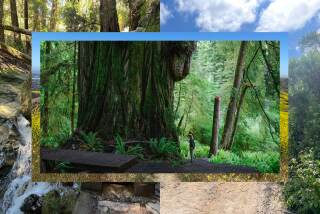State Parks: This Land Is Your Land
- Share via
All of us own this land--more than a million acres of it. This land has names like Anza-Borrego, Castle Rock, Grizzly Creek and Richardson Grove.
This land with the colorful names is the California State Park system, widely regarded as the nation’s finest. The California Department of Parks and Recreation administers 275 state park “units,” as park officials call them--a vast array of state parks, historic parks, reserves, recreation areas and beaches.
Far less known and less visited than California’s national parks, state parks preserve a cross-section of state ecology from the bottom of the Central Valley to the top of alpine peaks, from uncommonly dry desert lands where Joshua trees thrive, such as Saddleback Butte State Park, to the near-rain-forest environment of Del Norte Coast Redwoods State Park.
The multitude of intriguing park environments, and the many fine paths that explore them, add up to some world-class walking--some of the best in the West.
Gov. Pete Wilson has proclaimed this month to be California State Parks Month. Throughout the state, special events will highlight the diversity of natural and cultural attractions in the parks.
Many are offering special guided walks and hikes during May. Other parks are hosting festivals and historical celebrations. The parks described below have scheduled some intriguing activities.
Mono Lake Tufa State Reserve: Cradled by volcanoes, glacier-sculpted canyons and snowy peaks, Mono Lake is one of the most dramatic landscapes of the American West. Visitors marvel at the lake’s grand setting and the tufa formations (towers of calcium carbonate).
Take the easy one-mile Mark Twain Interpretive Trail to learn about the lake’s unique ecology and to view the many birds. Particularly abundant are eared grebes, duck-like diving birds.
Access: From U.S. 395 in Lee Vining, follow the signs to Mono Lake Tufa State Reserve. Telephone (619) 647-6331.
Col. Allensworth State Historic Park: This park commemorates African American history and the foresight of one of California’s visionary pioneers. Col. Allen Allensworth, a former slave, successful St. Louis restaurateur and the highest-ranking African American Army officer of his day, established a model town in the southern San Joaquin Valley in 1908. Allensworth is one of the few towns in the U.S. founded, financed and governed by African Americans.
On May 17, from 10 a.m. to 4 p.m., the park will host its annual Old Time Jubilee, a family festival featuring gospel and jazz as well as arts and crafts exhibits and an array of food for sale.
Visitors can walk the streets of the partially restored town, peer into the houses and buildings, and, with the help of interpretive exhibits and park rangers, get a sense of the many struggles and accomplishments of the people of Allensworth. On Jubilee Day, some of the original pioneers and their heirs will be on hand to discuss what life was like in this unique town.
Access: From California 99 north of Bakersfield in the town of Earlimart, exit on County Road J22 and head west eight miles to California 43. Turn south and drive two miles to Palmer Avenue. Turn right on Palmer and enter the park. Tel. (805) 849-3433.
La Purisima Mission State Historic Park: Of California’s 21 missions, the most fully restored is La Purisima, four miles north of Lompoc in northwest Santa Barbara County. La Purisima is the only mission with a sizable amount of land preserved around it--and the only one with hiking trails.
You could spend a fun day at La Purisima Mission State Historic Park in the Lompoc Valley, first heading for the Purisima Hills for a hike (two to five miles round-trip), then touring the mission. On weekends, the park holds its Mission Life Days and Purisima Peoples Days. You’ll find volunteer docents costumed as padres, soldiers and Chumash Indians, re-creating mission life of the 1820s.
Access: From U.S. 101 in Buellton, exit on California 246 and head west 13 1/2 miles to Purisima Road. Turn right and proceed a mile to La Purisima Mission State Historic Park. Tel. (805) 733-3713.
Point Mugu State Park: The park, the largest preserved area in the Santa Monica Mountains, boasts the finest native tall-grass prairie and one of the best sycamore groves in the state. The park is crisscrossed with pathways accessible to hikers of all ages and abilities.
On Saturday, the California Park Service and the Wilderness Institute are sponsoring Wheels to the Sea, a guided nature hike for physically challenged visitors. Wheelchair participants will roll from a mountaintop start at the Danielson Ranch to the ocean along four miles of dirt trail. At the park’s beach at trail’s end, the park will provide Sand Chairs with balloon tires to aid transportation to the ocean’s edge.
Wheels to the Sea is free, but reservations are required. Special buses for the physically challenged will depart for the park early Saturday morning from locations in the San Fernando Valley. Call the Wilderness Institute for more information; tel. (818) 991-7327.
Access: From Santa Monica, drive on California 1 north 32 miles to Point Mugu State Park. Tel. (818) 880-0350.
Providence Mountains State Recreation Area: Where else in Southern California can you explore some stunning scenery, be assured it won’t rain and know that the temperature will always be 65?
Mitchell Caverns, part of Providence Mountains State Recreation Area, is the place to go for close-up views of stalactites and stalagmites, cave ribbon, cave spaghetti and flow stone. Ranger-led walks through the dramatic limestone caves offer fascinating geology lessons.
Guided tours are conducted Monday through Friday at 1:30 p.m. On Saturdays and Sundays, tours begin at 10 a.m., 1:30 p.m. and 3 p.m. Tours are conducted until the end of May, when the caverns close for the summer months. A tour takes 1 1/2 to 2 hours. Tour fees are $6 adults; $3 children 6 to 12; ages 5 and under free.
Access: From Interstate 40, about 80 miles east of Barstow, exit on Essex Road and drive 16 miles to the road’s end at the Providence Mountains State Recreation Area parking lot. Sign up at the visitor center for tours. Tel. (760) 928-2586c
Tijuana River National Estuarine Research Preserve: Tijuana Estuary is one of the few salt marshes remaining in Southern California and an essential breeding and feeding spot for more than 170 species of native and migratory birds. From the excellent visitor center (a multi-agency project of California State Parks, the U.S. Fish and Wildlife Service and the California Department of Fish and Game), trails lead into the estuary and continue to the Tijuana River.
On Saturday, the Estuary Visitors Center will celebrate International Migratory Bird Day. Festivities begin at 9 a.m. with a two-hour bird walk.
Access: From Interstate 5 in Imperial Beach, exit on Palm Avenue. Go west 2 1/2 miles to Third Street. Turn left and drive half a mile to the visitor canter parking lot for the Tijuana River National Estuarine Research Preserve. Tel. (619) 575-3613
More to Read
Sign up for The Wild
We’ll help you find the best places to hike, bike and run, as well as the perfect silent spots for meditation and yoga.
You may occasionally receive promotional content from the Los Angeles Times.






